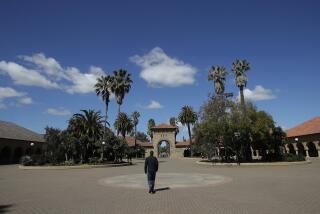What Georgetown’s atonement means for the campus debate over slavery
When one of American’s oldest and most prestigious universities decided to give preferential admission to the descendants of slaves with ties to the university, it immediately ramped up the pressure on other colleges to atone for their own complicated histories.
Georgetown University President John J. DeGioia announced Thursday that descendants of the slaves who built and worked at the Jesuit institution would be treated the same as legacy admissions candidates, such as those related to faculty and alumni.
He also said that two buildings on Georgetown’s Washington, D.C., campus would be renamed — one for a slave, the other for a black Catholic educator who founded a local school for black girls. The university will also launch a center to study slavery and commission a memorial to slaves.
The decision has divided students, scholars and the descendants themselves, while raising questions over how Georgetown will carry out its promises and how it might shape the path taken by other universities with ties to slavery.
Read Georgetown’s report on its history of slave ownership »
“This is the biggest news in reparations in years,” said Alfred Brophy, a professor at the University of North Carolina-Chapel Hill who studies the history of slavery and universities. Brophy, who is white, said Georgetown would “cause other schools to step up and do more.”
But William Darity, a professor of African American studies at Duke University who has spoken frequently on reparations, was less impressed. He described the move as “soft, easy, and inadequate.”
“There may be some marginal value associated with individual institutions taking steps to atone for their particular sins, but the sins of slavery, Jim Crow, and sustained discrimination and racism are collective, national evils and should be addressed at that level,” said Darity, who is black.
Georgetown, where students staged a sit-in outside the president’s office to demand the renaming of a building named for a past president with ties to the slave trade — a request granted Thursday — is not the first campus to examine its racist past. Activists, faculty members, and administrators elsewhere have struggled over dorms named after slave owners, displays of old art depicting slavery, and the iconic columns, rotundas and other university flourishes that were built by slaves.
At Yale, a cafeteria worker smashed a stained glass window pane depicting slaves picking cotton. At Princeton, students rallied after officials said they wouldn’t remove the name of Woodrow Wilson — who had shown support for the Ku Klux Klan — from campus buildings. And on Thursday, the University of Oregon’s president said that a campus building named after a KKK figure should be renamed, but that another one named for a university founder and KKK supporter should remain unchanged.
Georgetown is among more than a dozen universities that are part of a consortium on higher education and slavery at University of Virginia, where a commission is preparing a report on how to respond to its use of slaves, who once outnumbered students on the campus founded by Thomas Jefferson.
“We can’t ever fix or undo 400 years of American history. But we can do substantive things that suggest that it’s the 21st century now, we know the past is a stain on American history, and here is how we can do better,” said Kirt von Daacke, a historian and co-chairman of the UVA President’s Commission on Slavery and the University.
Von Daacke, who says other universities are “certain to learn” from Georgetown’s decision, suggested the outcome at other campuses could be different because many are public universities unlike Georgetown and must play by different rules when considering race in admissions.
Though Georgetown has said it will give preference for admissions to descendants of slaves, figuring out just who those descendants are is an ongoing process. The university has said there were 272 men, women and children who were sent to Louisiana after being sold from Maryland Jesuit plantations in 1838 to help finance campus operations. But it has not identified all of their living descendants, nor the descendants of other slaves — also now eligible for preferred admission — who worked on university grounds.
The preferential admission offer would put the descendants of slaves on par with legacy applicants. About 25% of legacy applicants are admitted, compared with the overall acceptance rate of 16%.
“Part of our ongoing research into our university’s historical role in the institution of slavery is to determine the descendants,” said spokesman Ryan Murphy, who said officials “do not know the exact numbers.” The school has increasingly focused on recruiting diverse applicants; of those accepted for its freshmen class, 11% were black, 17% were Asian and 11% Latino. Legacy applicants made up 10% of total freshman admissions.
Murphy said that legacy applicants “receive an extra look, and relationship to the university is one of many factors considered [in admission] but is not determinative,” and that Georgetown would “provide this care and respect for the descendants.”
For some slave descendants, that’s not enough.
“It is a step in the right direction,” said Karran Harper Royal, who traces her lineage back to the slaves sold in 1838.
Royal, who lives in New Orleans and traveled to Washington on Thursday to attend a ceremony where Georgetown’s president discussed the decision, said the school should go a step further in atoning for its past by offering scholarships to descendants.
Jaweed Kaleem is The Times’ national race and justice correspondent. Follow him on Twitter, Facebook and Instagram.
ALSO
Cornell University welcomes 12-year-old college freshman — the school’s youngest student ever
A flawed missile defense system generates $2 billion in bonuses for Boeing
More to Read
Sign up for Essential California
The most important California stories and recommendations in your inbox every morning.
You may occasionally receive promotional content from the Los Angeles Times.









